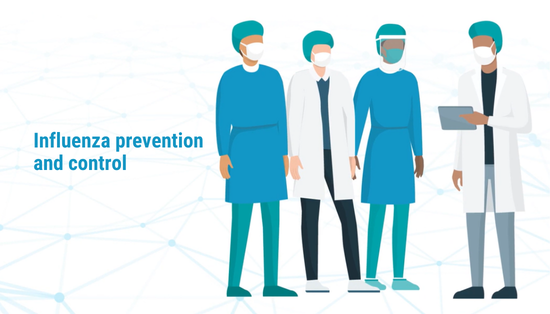
This course focuses on tools that can be used to prevent and control influenza. These tools include: seasonal influenza vaccines, diagnostics, and therapeutics.
Language: English
English
Influenza
Course information
This course is also available in the following languages:
Português - العربية - Русский - Español - 中文 - Français - Shqip
Overview: Influenza causes 3-5 million cases of severe illness and up to 650,000 respiratory deaths a year globally. Lower respiratory infections are the leading cause of death in low income countries annually. Some populations are particularly vulnerable to seasonal influenza, either because they have a greater risk of exposure or because they have a greater risk of developing severe disease: pregnant women; health workers; people with chronic health conditions (such as diabetes, HIV, asthma, heart or lung disease); people over the age of 65 years; and children from 6 months to 59 months.
This course provides an overview of the tools to prevent and control influenza. The training is intended for health workers and other stakeholders involved in preventing and treating influenza.
Learning objectives: By the end of this course, you should be able to:
- Explain the importance of influenza prevention and control;
- List the types of influenza vaccines and the target groups for seasonal influenza vaccination;
- Describe the process for diagnosing influenza; and
- Be familiar with WHO recommendations for the use of influenza therapeutics.
Course duration: Approximately 30 minutes.
Certificates: A Record of Achievement will be available to participants who score at least 80% of the total points available across all of the quizzes. Participants who receive a Record of Achievement can also download an Open Badge for this course. Click here to learn how.
Course contents
Module 1: The Importance of Seasonal Influenza Vaccination Programmes:
By the end of this video you should be able to explain how seasonal influenza vaccination programmes can help prevent and control seasonal influenza, strengthen countries’ health system, and help countries prepare for pandemics.Module 2: Seasonal Influenza Vaccine Types, Administration, and Target Groups:
By the end of this video, you should be able to describe the types of seasonal influenza vaccines, their administration, what makes seasonal influenza vaccines different from other vaccines, and the target groups recommended for seasonal influenza vaccination by WHO.Module 3: Influenza Diagnostics:
By the end of this module, you should be able to: describe the different types of influenza diagnostic tests and their use and the importance of proper specimen collection, storage, and transport.Module 4: Influenza Therapeutics:
By the end of this module, you should be able to: explain the steps and process for recognizing and treating severe influenza.
Enroll me for this course
Certificate Requirements
- Gain a Record of Achievement by earning at least 80% of the maximum number of points from all graded assignments.
- Gain an Open Badge by completing the course.